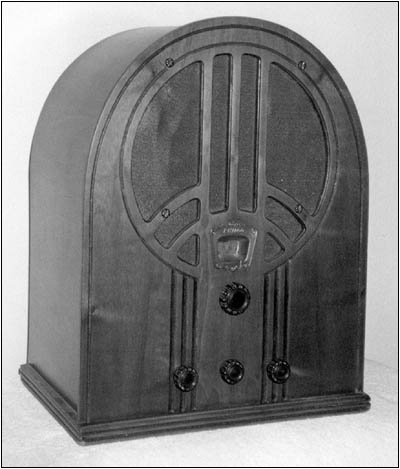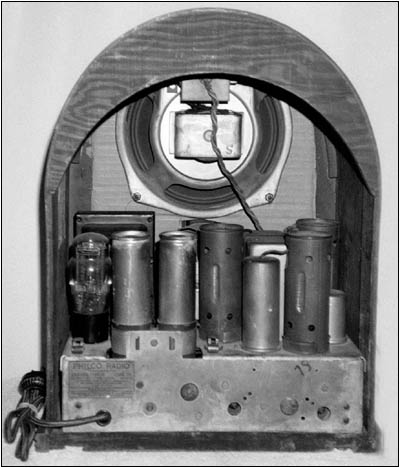Of Old Radios And Related Items--Published Monthly
1934 Philco Model 60
BY RICHARD ARNOLD
How collectors acquire their radios is often as interesting as the sets themselves. Richard Arnold shows us how to combine business with pleasure and come up with a nice addition to his collection. (Editor)
I sold my coin collection and started collecting radios in the summer of 1985. Why radios? I don't know. But what I do know, is that it turned out to be a very good decision. As Rush Limbaugh says on his radio program all the time, "I'm having more fun than a human being ought to be allowed to."
I was an insurance agent for over twenty years, and some of my customers came by my office and brought me radios and tubes. I used to include my radio cards in their monthly statements.
I knew in about six months after starting to collect that my main interest was going to be in cathedrals. One of my insurance customers sold me my first cathedral. It was an Atwater Kent Model 84, which I purchased for $75. I still have it.
The Philco Model 60
In late 1985, I started getting radio sales catalogs from Ron Boucher. He sent out a nice list of radio and related items that included pictures and a short description of each item. This Philco 60 was item #18 in his March 1986 catalog. He stated in his description of the radio that this version of the Philco 60 was the only one he had ever had.

Figure 1. This Philco Model 60 is one of my favorite radios.
Well, that statement impressed me (as a new collector) enough to go ahead and purchase it. I bought the set for $125. I purchased a number of other cathedrals from Ron over the next few years. He was very honest, and I never had any problems in my dealings with him.
This version of a Philco 60, shown in Figure1, is the second cabinet style for the year 1934. The first design looks a lot like my Philco Model 89, except for the escutcheon. The Model 60 is a 5-tube superhet that uses a 42 output tube, an 80 full wave rectifier, a 6A7 detector/oscillator, a 78 IF and a 75 as a second detector. The IF is 460 Kc. A rear view of the radio is shown in Figure 2.
The Philco 60 tunes the broadcast band from 530-1500 Kc. It also has a short wave band from 1.5 to 4.0 Mc. This band does not seem to have too much on it any more, but I do manage to pick up stations from time to time. Both the early and late versions of this radio are rated by Ron Ramirez as "somewhat difficult to find."
Over the years I have seen, mostly on television, pictures of various cathedrals that were painted in a flat looking paint that gave them a pastelappearance. I remember seeing a black and white picture on television of Bob Hope and some other people standing around a Jackson Bell "swan" cathedral that was painted and had this same look. A movie about Babe Ruth hitting his famous designated home run for a sick boy in the hospital shows a painted cathedral by his bedside.

Figure 2. This rear view of the Philco Model 60 shows the compact arrangement of the radio's components.
This Model 60 was also finished in a special off-white paint and highlighted in white paint. The painted knobs are wooden, round and flat. The set has a special sun ray grille cloth. I think the cabinet with the Deco design is pretty sharp looking.
It is interesting to note that Ron Ramirez's book Philco Radio 1928-1942 does not show any of the factory-painted Philco cathedrals. But, in a recent conversation with Ron, I found out that he doesn't mention the Philco 60 because he can find no evidence of its being painted by the factory. The first sets to show up painted were done in 1938-1939, as evidenced by the 39-6 and 39-7 table models.
I would like to find out more about these sets. If any one has any of the painted cathedrals in his collection, please tell me what you have. A picture would be nice, along with any information. I will try to gather enough facts for a future article in Antique Radio Classified.
I like to play all of my radios on a regular basis, but when I get to this one, a favorite, I really enjoy listening to it.
References:
Boucher, Ron. Sales Catalog, March 1986.
Ramirez, Ron. Philco Radio 1928-1942. Atglen, Pa.: Schiffer Publishing, Ltd., 1993.
(Richard Arnold, P.O. Box 275, Lone Grove, OK 73443)
Richard Arnold, a frequent contributor to A.R.C., has been collecting radios since 1985. Primarily interested in cathedrals and 1920s battery sets, his collection ranges from crystal sets to a 1928 American Bosch in a Pooley cabinet. The 1932 Jackson-Bell Peter Pan featured in the June 1991 A.R.C. is his prize.
| [Free Sample] [Books, etc., For Sale] [Subscribe to A.R.C./Renew] [Classified Ads] [Auction Prices] [Event Calendar] [Links] [Home] [Issue Archives] [Book Reviews] [Subscription Information] [A.R.C. FAQ] URL = http://www.antiqueradio.com/Aug02_Arnold_Philco60.html Copyright © 1996-2002 by John V. Terrey - For personal use only. Last revised: August 2, 2002. For Customer Assistance please contact ARC@antiqueradio.com or call (866) 371-0512 Pages designed/maintained by Wayward Fluffy Publications
Antique Radio Classified |